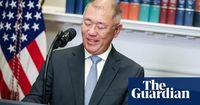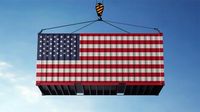As the global economy navigates a convoluted landscape of tariffs and inflation, small-cap stocks are experiencing a resurgence, yet the outlook remains cautiously optimistic due to uncertainties surrounding trade policies. Investors are starting to take notice of small-cap stocks as inflationary pressures that hindered these companies appear to be easing. However, concerns have been reignited following President Donald Trump’s threats of new tariffs which could impose additional inflation burdens on small-cap firms.
Laura Cooper, a global investment strategist at Nuveen, echoed these sentiments, stating that a broad 10% tariff could increase core inflation in the U.S. by as much as 0.3 percentage points. Cooper noted, “We became more constructive on U.S. small caps in the fourth quarter of last year, and this was largely reflected by U.S. exceptionalism and the fact that we were likely going to see a broadening of opportunities in the U.S. But we’ve tempered that view more recently, and that largely reflects the uncertainties we’re seeing on tariffs.” Small-cap companies, which typically lack the financial cushion of larger enterprises, could struggle to absorb such inflationary pressures.
Tara Fitzpatrick, manager of the Schroder Global Multi-Asset range, also pointed out that small companies are particularly sensitive to the economic climate. “They are debt-reliant businesses that are very dependent on easy financing. Add in a layer of inflation concerns from tariffs to that,” she said. Fitzpatrick withdrew from significant investment in small caps due to the challenging market environment since 2021 and had taken only a fleeting step back into the sector following Donald Trump’s re-election late last year, viewing that position as a temporary, “tactical bet based on sentiment.”
Meanwhile, across the ocean, the Eurozone is facing its own set of economic challenges. The EUR/USD pair has seen recent fluctuations as geopolitical factors weigh on the U.S. dollar. The index, tracking the greenback against six major currencies, fell from an over two-week high of 104.50 to near 104.00 as traders reacted positively to Trump’s softened stance on tariffs during a press briefing. Trump revealed on March 24 that not all tariffs would be implemented as anticipated on April 2, which buoyed market sentiment and eased fears of a full-blown trade war.
The Services Purchasing Managers’ Index (PMI), a key gauge of economic health, increased to 54.3 in March, significantly beating February’s score of just 51.0. Atlanta Fed Bank President Raphael Bostic’s comments about only expecting one interest rate cut this year further reinforced the dollar's recent strength, even amid rising consumer inflation expectations attributed to Trump’s trade policies.
Meanwhile, the European Central Bank (ECB) is likely to cut interest rates again in April due to sluggish economic conditions, having already reduced rates six times since June 2024. As traders adjust expectations of ECB dovish moves amidst potential tariff-induced inflation, Germany’s IFO Business Climate data showed a slight increase, coming in at 86.7, although it missed estimates.
Against this backdrop, gold prices have also started to dip after a meteoric rise. Following a record of $3,065.20 on March 20, gold futures have corrected down to $3,015.60, reflecting selling pressures linked to a stronger U.S. dollar and uncertainty stemming from potential trade shifts. Analysts suggest the ongoing geopolitical tensions and expectations for forthcoming tariffs could further govern gold’s price trajectory.
Economic experts have pinpointed a support level for gold futures at about $2,970, with any potential tariff announcements on April 2 signaling vital reactions in market sentiment. The price movement denotes both caution and eagerness among investors with inflation levels at the forefront of their minds.
Amidst these developments, South Korean automobile manufacturer Hyundai is gearing up to make a significant $21 billion investment in the U.S. market. With plans to invest $9 billion by 2028 to enhance U.S. production and create around 14,000 full-time jobs, Hyundai aims to solidify its operations in response to potential tariffs by the Trump administration. The investment will enhance production capacity, particularly at its facilities in Alabama and Georgia, as well as introduce a new steel plant in Louisiana.
Trump has openly praised Hyundai’s plans, reiterating that such investments show tariffs can spur domestic investment: “This investment is a clear demonstration that tariffs very strongly work,” he said, adding that the U.S. would see more levies on autos and other products in the coming days.
As trade tensions continue to develop, major U.S. automakers, including General Motors, remain apprehensive amid discussions concerning new tariffs on auto imports. GM CEO Mary Barra recently communicated to Trump the company’s intent to invest $60 billion in the U.S. while highlighting the need for clearer tariff policies.
The upcoming weeks are likely to prove crucial as both domestic and global markets react to potential new tariffs and their consequent economic implications. Investors will be closely monitoring messages from the Trump administration and adjustments in fiscal metrics to gauge market momentum. With numerous variables at play, the delicate equilibrium of the global economy remains under scrutiny.






